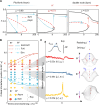Achieving symmetric snap-through buckling via designed magnetic actuation
- PMID: 40367173
- PMCID: PMC12077511
- DOI: 10.1126/sciadv.adw1259
Achieving symmetric snap-through buckling via designed magnetic actuation
Abstract
Symmetric snap-through buckling, although both theoretically achievable and practically advantageous, has remained rare in bistable systems, with most studies favoring asymmetric snapping due to its lower energy barrier. Previous observations of symmetric snapping have been limited to high loading rates. In this work, we present a universal strategy to achieve symmetric snapping under quasi-static conditions by designing magnetization (M)-interface patterns that effectively suppress asymmetric modes. A simplified theoretical model demonstrates that this behavior results from the interplay between pitchfork and saddle-node bifurcations, with predictions validated through simulations and experiments using hard magnetic elastomers. Resisting forces generated by multiple M-interfaces counteract asymmetric snapping, enabling distinct symmetric configurations. Extending this approach to higher-order symmetric snapping, we uncover a quasi-linear scaling law between critical fields and snapping order. These findings establish a robust framework for designing snapping systems with enhanced control and predictability, as demonstrated by a mechanical-magnetic snapping switch, paving the way for advanced applications in precision engineering and magnetic-mechanical actuation.
Figures





References
-
- Forterre Y., Skotheim J. M., Dumais J., Mahadevan L., How the Venus flytrap snaps. Nature 433, 421–425 (2005). - PubMed
-
- Erbil S. O., Hatipoglu U., Yanik C., Ghavami M., Ari A. B., Yuksel M., Hanay M. S., Full electrostatic control of nanomechanical buckling. Phys. Rev. Lett. 124, 046101 (2020). - PubMed
LinkOut - more resources
Full Text Sources

